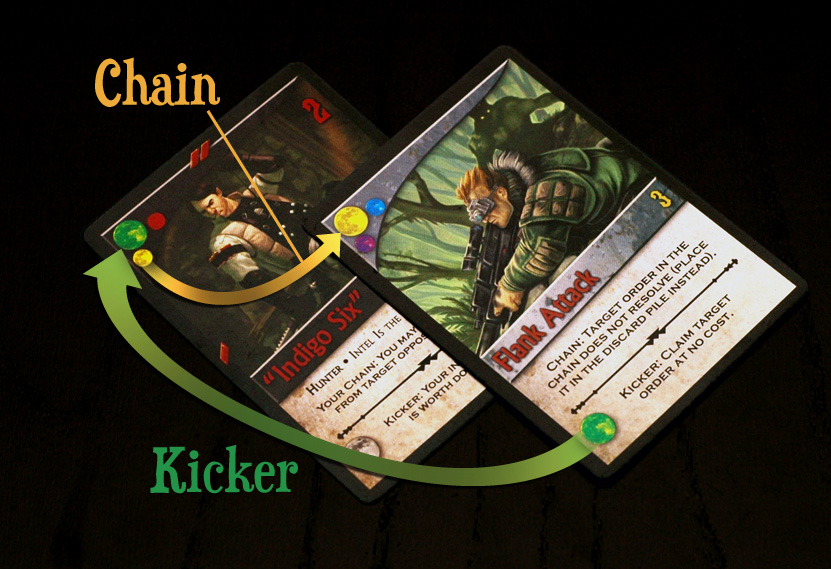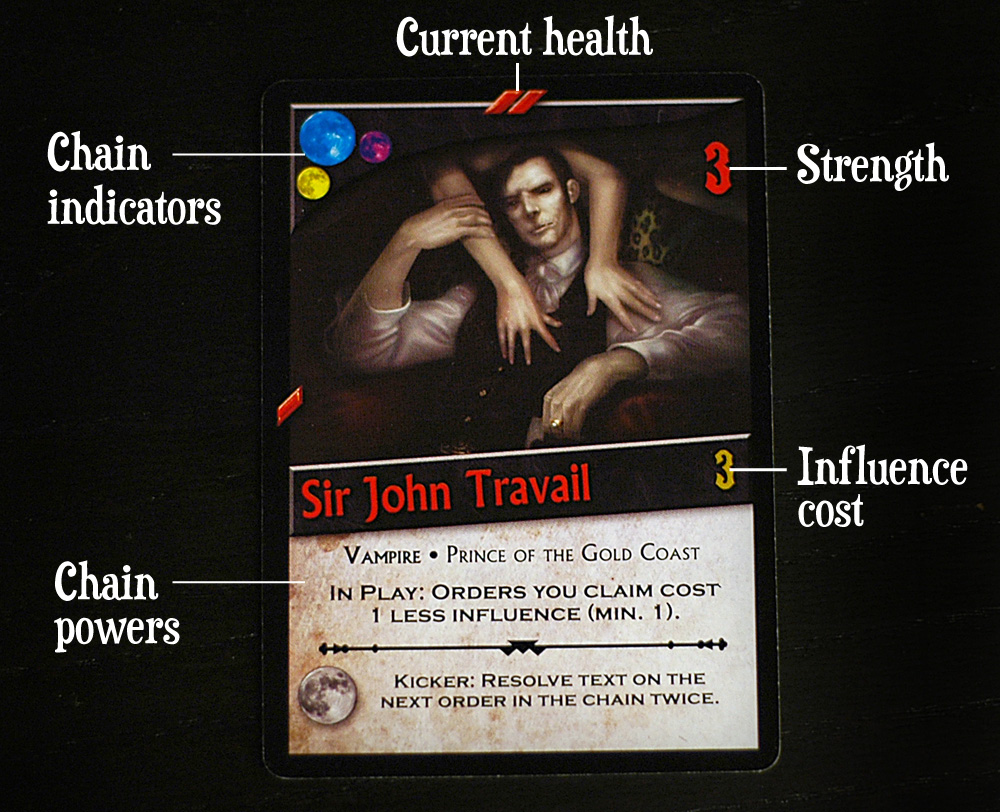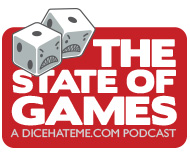The Quick and the Undead: A Nightfall Review
One thing about living in Santa Carla I never could stomach; all the damn vampires.
 For those gamers not in the know, Nightfall is the new horror-themed,“direct conflict” deck-building game from AEG that feels a bit like the love child of Dominion, Magic: The Gathering and the old, classic Killer Instinct video game. Just as in Dominion, each player starts the game with a small collection of cards in their personal decks and can later augment those decks by drafting cards from stacks of other cards during their turn. Unlike Dominion, players are able – through the use of carefully played orders and minions – to deal direct damage to their opponents, sending wound cards into the opposing decks. The overall goal of Nightfall is to take as few wounds as possible (not an easy feat) and be the least bloodied badass when the dust has settled.
For those gamers not in the know, Nightfall is the new horror-themed,“direct conflict” deck-building game from AEG that feels a bit like the love child of Dominion, Magic: The Gathering and the old, classic Killer Instinct video game. Just as in Dominion, each player starts the game with a small collection of cards in their personal decks and can later augment those decks by drafting cards from stacks of other cards during their turn. Unlike Dominion, players are able – through the use of carefully played orders and minions – to deal direct damage to their opponents, sending wound cards into the opposing decks. The overall goal of Nightfall is to take as few wounds as possible (not an easy feat) and be the least bloodied badass when the dust has settled.
At the beginning of the game, each player receives the same two copies of six starter cards to form their main deck. Players are then dealt four “draft” cards from the main supply, choosing one to keep and passing the rest to the player on the left. Players then choose another card, and pass again. These two chosen cards will become the player’s private archives, and only they can draft cards from this area. The players then choose one of the remaining two cards to place in the middle of the playing area. This will form the commons where any player may draft. The remaining draft card is discarded. The commons are then filled with draft cards until there are eight total drafting possibilities. The draft cards are then replaced with full draft stacks and play begins.
Gameplay
Gameplay is relatively simple, and broken into four stages:
- COMBAT – At the beginning of every player’s turn, all of their minions in play must attack. Players decide which minion is attacking each player. The defending player may use minions they have in play to block attacks, but any leftover damage not blocked by a minion is taken by the player, who places the appropriate amount of wound cards into their discard piles. At the end of combat, the active player must remove all minions from play (with the exception of a few special cards which do not discard after combat).
- CHAIN – This is the trickiest part of the game, and the game’s core mechanic. The active player begins a chain by playing a card from their hand on the table, and can then link other cards to that card depending on the color of the moons in the card corner. If the color of the large moon on any other card in the player’s hand matches a color of the smaller, secondary moon(s) on the main card, the player may then play that card, as well. Chaining continues until the player chooses not to chain, or has no more chains in hand. The player to the left of the active player can then add to the chain, playing any cards that match the secondary moons of the last card in the previous player’s chain. After all players have had a chance to place cards in the chain, the chain is resolved, beginning with the last card played by the last player and proceeding backwards. This is how all actions are resolved and also how players can bring new minions into play to attack and block damage.
- CLAIM – In order to customize and build their decks, players need to spend influence to “buy” new cards. Every turn, the active player gets two influence points to spend. The number of influence points can also be increased through certain card resolutions in the chain phase. Players may also discard any card from their hand for one influence point each. All new cards are placed into the player’s discard pile.
- CLEANUP – The active player draws cards from their draw deck to fill their hands to five cards. If any of the cards in hand after drawing are wound cards, these can be discarded in order to draw more cards. Ultimately wounds are bad, but they can be beneficial during the game to draw more cards, and more cards means more opportunities to chain!
Strategy
Since each player starts the game with the same 12 core cards, the main strategy in Nightfall lies in intelligent card drafting, paying special attention to the primary and secondary moon colors. This can be the difference in building effective chains which will lay waste to your opponents and provide crucial blockers. If you can’t chain in this game, you’re dead meat. However, that said, players shouldn’t always just chain whenever they can – knowing when to chain effectively often requires patience and prudence. In a recent game, one player chained almost every card in hand during opponents’ turns, leaving him with no way to gain influence and draft more powerful cards. This also meant he was usually the one with several menacing minions on the table, which typically paint a very large target for immediate abuse by the other players.
Also important to note is that combat is fast, furious, and mandatory, so Nightfall is not for the weak-hearted or thin-skinned. This game can be brutal, and diplomacy can often be a bitter pill to swallow. It’s hard to convince someone not to attack you when you just threw a werewolf the size of a bus at them for five wounds. The key is to find just the right balance of spreading the damage around so as not to be the one attracting the most attention at the table. This can sometimes mean saving a minion for just the right moment and taking a couple of wounds.
For the most part, Nightfall is a quick, mostly-enjoyable, albeit savage, affair. The rules are very easy to pick up, and beginning players can typically hold their own at the table after they get the knack of drafting and chaining. Player reaction has been mixed, however – some love the brutality and the chaining mechanism, while others have said they prefer the more calm and relaxed Dominion and Thunderstone. Personally, I would rather order around a horde of undead and lycanthropic minions, ready to break some heads and chomp some necks, than take a leisurely stroll down to the town market- but that’s just me.
Flaws and Feedback
As enjoyable as Nightfall has been to play, it does have its flaws. The biggest of these – and also the most subjective – is the theme. The universe that AEG has created for Nightfall is fantastic, and the storyline that Kenneth Hite weaves in the rulebook is awesome. However, I find it difficult to reconcile the theme and create a story as the game is played. Almost every minion in the game has a specific name, not a title, so when multiple copies of the same minion are in play, it creates a bit of thematic discord. There are plenty of times when “Bad Smoke” will be blocking for everyone, and you’ll send a couple of J.J. MacTeagues in to pummel a player. This problem is not as evident in games like Dominion, which gives generic titles to a card like “Market” or “Library.” Admittedly, Dominion’s theme is far weaker than that of Nightfall, but the point still stands.
I contacted Todd Rowland, Senior Brand Manager at AEG, to get his opinion on the issue; he explains through the model of Legend of the Five Rings:
“This was a conscious decision. 15 years ago when we were designing L5R, we had a choice to make. Will this card be “Young Lion Samurai” or will it be “Matsu Gohei.” We knew that people could have up to 3 Matsu Gohei on the table, and in a Lion/Lion match there might be six, swinging big swords at each other! But ultimately we decided that while “Young Lion Samurai” might help maintain a certain idea of theme, “Matsu Gohei” was someone. He had a life, he had a story. And we could tell that story. And I think no one can argue that L5R isn’t one of the greatest examples of theme and story leading the game in the history of gaming. (Editor’s note: I would not argue that point)
So we decided to stick to our guns. It may be a little odd to see Alton Hickman vs. Alton Hickman, but ultimately Alton represents someone who has some skin in the game, and to us, that’s infinitely cooler than ‘Mist Vampire.’”
Another aspect of Nightfall I wasn’t entirely happy with also relates to theme. In the universe that AEG is creating, all the creatures of the night sometimes work together, even with human allies, to fulfill a certain agenda. Now, being an old school horror buff and horror gamer, there have been many an occasion when I’ve commanded a lycan pack or hunted down some bloodsuckers as a human hunter. As it stands right now, the creation of unified factions is impossible under the structure of draft, and in the numbers of cards. Vampires outnumber werewolves and humans almost 3 to 1, so creating a competitive deck that doesn’t include vampires isn’t feasible.
Todd Rowland also commented on this decision: “Yes, right now there wouldn’t be enough of certain groups to do any “straight werewolf” or “straight human” decks. There simply aren’t enough cards. That might become more possible, but while that isn’t a direct concern of ours in the design, you will start to see more cards that work specifically better with or against certain traits.”
One final note on flaws outside of theme is in player drafting disparity in a large multiplayer game. In a game with the full five players, there is often a good chance that a particular card in the commons will be fully drafted by the time the fifth player’s turn begins. This happened in a recent game; I sent the hulking vampire Vulko to the commons so that I could develop successful chains with my private archives. I ended up being the last player to take a turn, and by that fifth turn, there was a table run on Vulkos and I was unable to draft. I was left with a hobbled chain selection for most of the game, not to mention a lack of any significantly-sized minions with which to block the hordes of Vulkos storming at me from four sides.
Todd Rowland also provided his take: “I often find that in a lot of cases the relative power-level of certain cards depends on the group. Much like in a CCG (collectible card game), your playgroup has its own metagame, with its own assumed value of certain cards and abilities. Other groups may recognize power in Vulko but may weigh someone like Blaine or Alton higher. It varies. Not saying Vulko isn’t strong, he is, but it’s often an inflated sense of his usefulness in the metagame than actually on the table. That said, again, much like anything, expansions tend to change the vibe of cards, and Vulko is no exception.”
For the most part, I can agree and see Todd’s stance on the flaws I mentioned. There is still a part of the purist in me that will be a bit put off by the inability to dominate the game with only lycanthropic shapeshifters (power to the pack!) but the game leaves plenty of room for house rules and variants to change all that (not to mention the coming expansions). As for multiplayer disparity, I would say that, although the game can handle up to five players, this is probably one best played with a smaller group. The sweet spot seems to be around three players – enough to prevent the complete head-to-head slugfest of a two-player affair, but small enough that no one will get ganged up on when there’s blood in the water.
| Gameplay/Replay | Components & Theme | Fun |
|---|---|---|
| Overall score: 15 out of 18 - Not sure if it's a Dominion killer, but for a welcome change, I'd recommend this thriller. | ||
Nightfall is a game for 2-5 fiends, ages 12 and up, from Alderac Entertainment Group – home of some of the finest card games on the planet. You can purchase Nightfall from Funagain Games for $31.99, or from your favorite local game store.
![]() Did you know that when you buy from Funagain Games that you’re helping out this site? It’s true! Get games, help out your favorite blog. It’s win/win!
Did you know that when you buy from Funagain Games that you’re helping out this site? It’s true! Get games, help out your favorite blog. It’s win/win!
Related posts:
- Before Nightfall: An Interview with Todd Rowland of AEG
- Great Odin’s Goat! A Trollhalla Review
- Enter the Rabbit – A Cookie Fu Review
- Launch Pad: In Space, No One Can Hear You Whimper
- Dice Hate Me at the Bookstore: The Games Bible







Comments
2 Responses to “The Quick and the Undead: A Nightfall Review”Trackbacks
Check out what others are saying...[…] Nightfall […]
[…] zombies, vampires, and direct player interaction. Maybe this isn’t so bad, after all. Thankfully, my step back was worth it – Nightfall turned out to be one deck-builder I actually enjoyed, even if some of the players […]